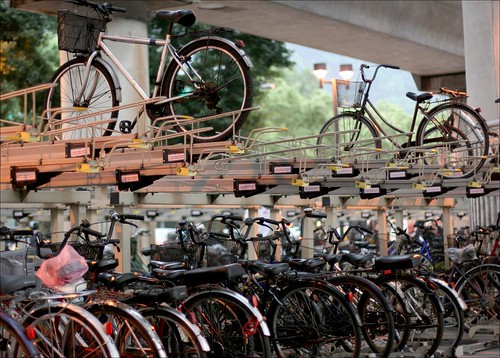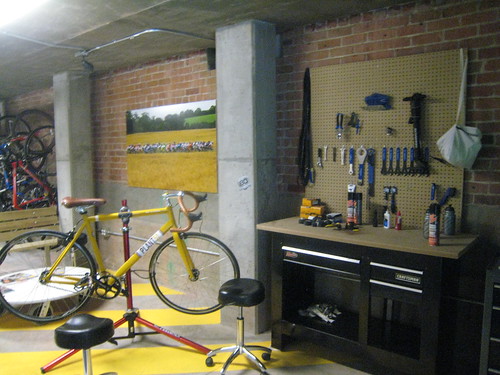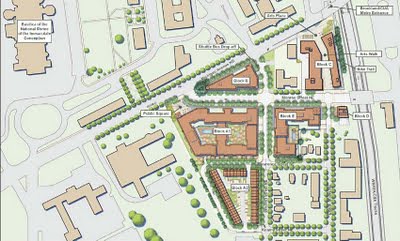Rethinking the best way for urban apartment buildings to support biking
Washcycle calls our attention to an article in the Gazette, "College Park officials ready to back new housing project: Project to bring apartments and retail could break ground in fall," about how the new Domain College Park 256 unit apartment project agreed to pay for a 7 dock bicycle station with 4 bikes.
I don't think that itty bitty bike sharing stations are the best way to integrate bicycle accommodation into large mulitunit apartment and condominium buildings, at least in more urban settings.
First, WABA made an excellent point in their comments to the DC Zoning Commission on bicycle parking, that according to the 2001 National Household Travel Survey there are 0.86 bikes per household. It seems clear that a fractional requirement of 0.75 bicycle parking spaces per unit will not meet current demand (although it would be helpful to have DC-specific data). (See this Washcycle entry for more.)
Second, therefore building regulations should require that one or two bicycle parking spaces be provided per unit, depending on the expected population of the building, and depending on the "urbanness" of the location--e.g., apartment buildings in the core of the city should have higher requirements than places in outlying parts of the city, and this concept of providing greater numbers of bicycle parking spaces for buildings in settings where bicycles are likely to used should be extended regionally.
Third, of course the parking should be secure (locked with secure entry only for those people with bikes), to be congruent with best practices in bicycle parking, which distinguish between the needs of short term parkers (visitors/customers) vs. long term parkers (residents/employees).

Flickr photo of two tier bicycle racks by hey-gem
Finally, it would be nice if buildings looked at the provision of bicycle support as a premium amenity, comparable to the Bicycle Kitchen facility in the Plant51 housing development in San Jose, California.

Flickr photo of the Plant51 Bicycle Kitchen repair set up by Jimmy-Lin
I think we can look to the methods for providing support for bicycling on college campuses for guidance with regard to apartment buildings. There are five different methods that I've come across (in addition to having a bike shop/repair facility on campus, programming, bike parking, bike lanes and other bicycle infrastructure, ideally a bicycle and pedestrian coordinator, etc.):
1. Give students a free bike (with some conditions) as a transportation demand management strategy designed to reduce automobile traffic, parking demand, and the space required to park cars(Ripon College Velorution program)
2. Bike library -- you can go to the Rec. center and check a bike out. But it requires labor and space and can only be done when the center is open. This is more for casual and recreational use rather than transportational use.
3. Rental by the term. At North Central College, for $30/term, you can rent a bike and you get a lock and helmet too. And depending on the program, free repairs. This is for TDM purposes and limits the amount of program management and labor demands imposed by the bike library.
4. Discounted purchase programs like the Fuji University program by Fuji Bicycles, which is in place at many universities including Michigan State, Emory University, Temple University, and Brigham Young University. With this kind of program, not unlike discounted software pricing made available to students, the university doesn't have to worry about anything, it's taken care of by the local Fuji bicycle dealer.
5. Bikesharing programs. Just like the traditional bicycle programs, but with different equipment and university support, such as the Zotz bicycle sharing program at UC Irvine. The problem with bikesharing programs is that they are capital, managerially and operationally intensive, and need a high density of stations to provide a useful and usable service profile.
Some hotels (Starwood W Hotel webpage, "Europe on Two Borrowed Wheels" from the New York Times), office buildings (see "Property Funds See the Value in Being Green" from the New York Times), and an apartment building in Tokyo ("Residents of the Muji village can take advantage of free Muji bikes," photo from the Independent) have bicycle programs, either for free as an amenity or for a small charge.
I think with the Domain College Park apartment project, with 256 units targeting upscale residents, that the City of College Park, instead of getting a one-time donation of $54,000 for an 11 bicycle sharing station (even though they settled for a 4 bike, 7 dock station), should have instead required the provision of secure, protected parking for at least 400 bicycles (with a provision for expansion depending on demand), and the offering of a program of a rental bicycle program comparable to how the Term rental program works at North Central College. For $5 or $10/month, the tenant can get a bike and a lock and a space to park in the secure bicycle parking station.
For about $60,000, you could buy at least 100 bicycles, 100 locks, and pay for most of the set up cost for a secure parking facility for 400 bicycles. That would end up supporting active bicycle use far more than one 11 bike sharing station.
This type of program should be promoted as part of more comprehensive transportation demand management protocols created as part of the development review and approval process for construction of new multiunit housing proposals.
Labels: bicycle parking, bikesharing, resident attraction programs, sustainable transportation, transportation planning




0 Comments:
Post a Comment
<< Home